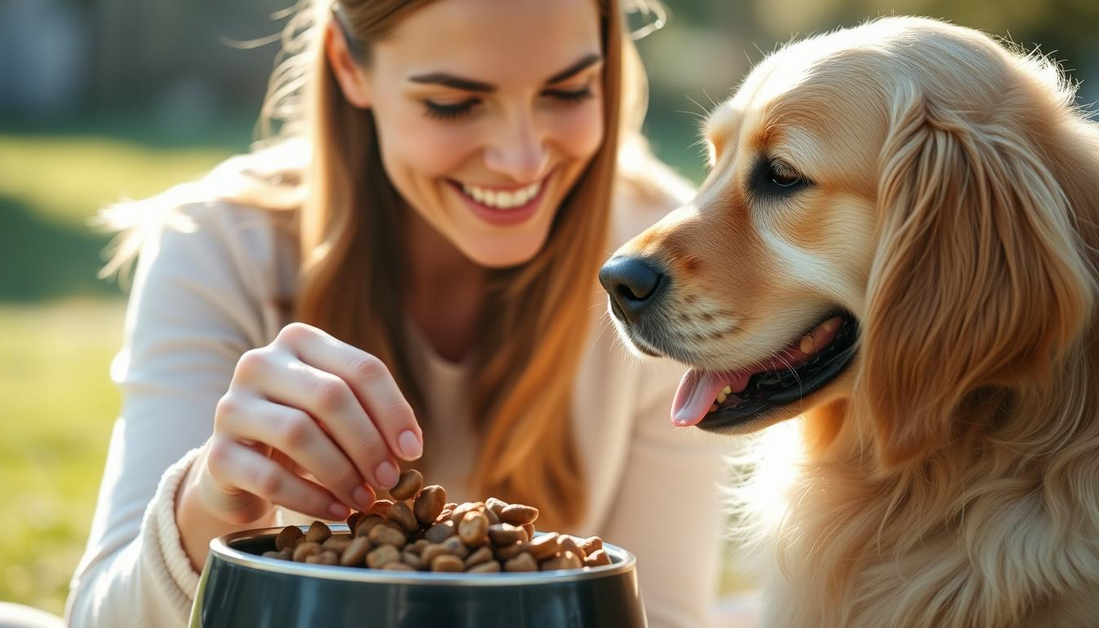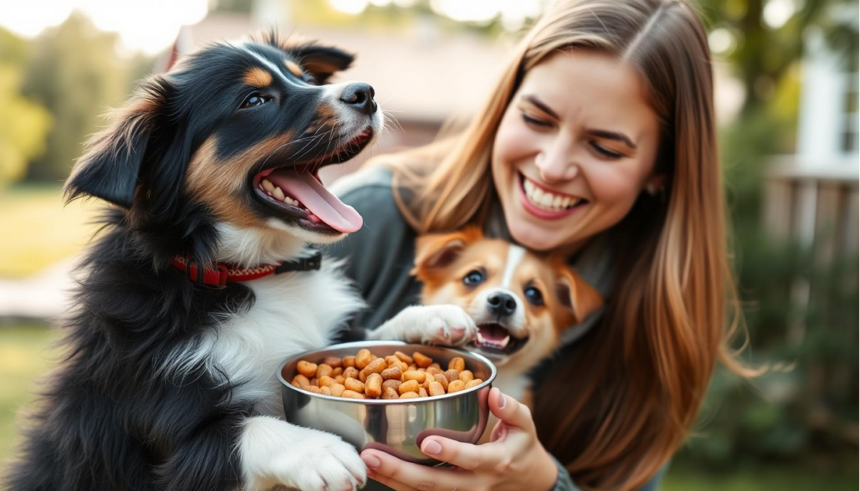India customers to view on amazon.in
Pet Nutrition Trends: Is Raw Feeding Still the Best Choice?
Pet owners today are exploring pet nutrition trends more than ever. They have many options like premium kibble, freeze-dried meals, and raw diets. Many wonder if raw feeding is still the best for pets.
- The Evolution of Pet Nutrition Trends
- Understanding Raw Pet Diets: What They Actually Contain
- The Science Behind Raw Feeding: What Research Tells Us
- Recent Studies on Raw Diet Benefits
- Potential Health Risks Identified by Researchers
- What Veterinary Nutritionists Are Saying
- Pros and Cons of Raw Feeding for Dogs and Cats
- Popular Alternatives to Raw Feeding in 2025
- Sustainability in Pet Nutrition: Environmental Impact of Different Diets
- How to Create a Balanced Raw Diet If You Choose This Path
- Common Myths About Raw and Commercial Pet Foods Debunked
- Tailoring Your Pet’s Diet to Their Individual Needs
- Conclusion: Making the Best Nutritional Choice for Your Pet
- FAQ
- Is raw feeding really the best option for pets?
- What are the key ingredients in a raw pet diet?
- How do I transition my pet to a raw food diet?
- What do veterinary nutritionists say about raw diets?
- Are there any health risks associated with raw feeding?
- What alternatives are trending in pet food for 2025?
- How can I ensure my pet’s diet is sustainable?
- Can a raw diet help with pet allergies?
- What are the benefits of a balanced raw diet?
- Why is holistic pet nutrition important?
- What common myths exist about raw and commercial pet foods?

This article looks at how pet food trends have changed in 2025. It balances science, safety, and pet well-being. Raw feeding pets used to be a new and exciting choice. But now, new research and innovations are changing the conversation.
As pet parents focus on health, they question if traditional raw diets are still up to date. This guide helps by comparing raw feeding to new alternatives. It talks about safety, nutrition, and sustainability.
Key Takeaways
- Pet food trends now include advanced kibble, fresh options, and raw diets.
- Raw feeding pets remains popular but faces scrutiny over safety and nutritional balance.
- 2025 sees rising focus on sustainability in pet nutrition choices.
- Science and pet health outcomes are key to debates over is raw feeding still the best option for pets?
- Modern diets must address age, breed, and health-specific needs.
The Evolution of Pet Nutrition Trends
Pet diets have changed a lot over time. This change shows how the pet food industry has grown and changed. Let’s look at the important moments in pet nutrition trends 2025.

Historical Perspective on Pet Feeding
Before the 20th century, pets ate leftovers from human meals. Their food included meat scraps, grains, and leftovers. This way of eating was common but not always good for their health.
How Modern Pet Food Developed
After World War II, the pet food industry started to grow. Some big changes happened:
- 1950s: Dry kibble became a popular choice because it lasted longer.
- 1990s: New premium foods with organic and grain-free options were introduced.
- 2020s: Foods were made with science to meet specific needs like age and health.
The Rise of Raw Feeding Movement
“Dogs and cats thrive on fresh, unprocessed foods.” – Ian Billinghurst, BARF diet pioneer
In the 1990s, Ian Billinghurst, an Australian vet, started the BARF diet. He believed in feeding pets raw foods like meats, bones, and veggies. This idea has influenced popular pet food trends today, like using human-grade ingredients and simple recipes.
By 2025, pet nutrition 2025 will keep getting better. It will mix old ideas with new science. This way, pets will get food that’s right for their bodies and lives.
Understanding Raw Pet Diets: What They Actually Contain
Raw feeding for pets isn’t just about raw meat. It’s a complete diet that includes muscle meat, organ meats, and raw bones. Raw food for pets also has fruits and vegetables to mimic the digestive system of prey.

Commercial raw pet food comes in frozen patties, freeze-dried snacks, or pre-mixed meals. These often have added vitamins. Homemade diets need owners to mix ingredients carefully, ensuring the right balance of meat, bones, and organs.
| Commercial Raw Food | Homemade Raw Diet |
|---|---|
| Pre-portioned; nutritionally balanced | Requires meal planning |
| Ready-to serve | Risk of imbalances if not researched |
Cats need more protein than dogs, so their raw diet is different. The cat raw diet must include taurine for heart and eye health. Commercial brands often use synthetic taurine, while homemade diets use liver or supplements.
“Cats are obligate carnivores. Their raw diet must prioritize meat-based proteins with no grains,” states the Feline Nutrition Foundation.
Whether you buy it or make it yourself, raw diets aim to mimic wild eating patterns. But, owners must do their research to avoid nutritional gaps, especially for cats needing taurine.
The Science Behind Raw Feeding: What Research Tells Us
Research in pet nutrition keeps evolving, sparking debates on raw diets. Scientists and vets now study both the good and bad sides. They do this through controlled studies and real-life observations.

Recent Studies on Raw Diet Benefits
- Improved dental health linked to raw-fed pets in a 2023 study
- Shinier coats reported in 78% of cases studied by the Journal of Veterinary Internal Medicine
- Reduced allergy flare-ups noted in dogs with grain sensitivities
Potential Health Risks Identified by Researchers
- Risk of Salmonella contamination in 15% of raw diets tested
- Nutritional deficiencies found in 30% of homemade raw recipes
- Bone-related intestinal injuries reported in 2-5% of cases
What Veterinary Nutritionists Are Saying
“Properly formulated raw diets can work, but require expert guidance to avoid risks.” – Dr. Lisa M. Freeman, board-certified veterinary nutritionist
Vets have mixed views on raw diets for pets. Some support vet-approved diets that meet species needs. Others prefer balanced commercial formulas. The American College of Veterinary Nutrition advises talking to certified specialists before changing diets.
Pros and Cons of Raw Feeding for Dogs and Cats
Deciding between raw diets and kibble means looking at the pros and cons of raw pet diets. Fans of raw feeding say it improves digestion and makes coats shine. Critics worry about the risk of bacterial contamination.

| Pros of Raw Feeding | Cons of Raw Feeding |
|---|---|
| Enhanced energy levels | Risk of bacterial exposure |
| Reduced allergy flare-ups | Higher cost and preparation time |
| Leaner body condition | Difficulty ensuring balanced nutrition |
Kibble is easy and cheap but might not have all the nutrients of fresh food. Raw diets need careful planning. Vets suggest getting help to avoid missing out on important nutrients.
Many pet owners mix both raw and kibble. They use raw meals sometimes and kibble for balance. Think about your pet’s health and your lifestyle. Raw feeding is good for active pets, but busy people might prefer a mix.
Always put your pet’s safety first. Talk to a certified pet nutritionist before changing their diet.
Popular Alternatives to Raw Feeding in 2025
Pet owners looking for something other than raw diets have many choices now. In 2025, new options blend convenience with nutrition. Here are the top picks for a healthy pet diet.

Premium Kibble Innovations
Brands like Orijen and Blue Buffalo Wilderness are leading the way. They offer kibble with 60%+ real meat and no artificial additives. Their use of pressure extrusion keeps nutrients in, unlike regular kibble.
They have special formulas for senior dogs, joint health, and allergies. These are the best dog foods for 2025.
Freeze-Dried & Air-Dried Options
| Type | Key Features | Benefits |
|---|---|---|
| Freeze-Dried | 98% moisture removal | Retains enzymes, 10-year shelf life |
| Air-Dried | Low-heat dehydration | Soft texture, no rehydration needed |
Stella &Chewy offers freeze-dried raw meals that don’t need refrigeration. Northwest Naturals has air-dried options with 98% meat. Both fit the healthy pet food trends of 2025, offering raw-like nutrition without the risks.
Gently Cooked Fresh Foods
- Paté-style products (e.g., Tiki Dog) retain 85% nutrients post-cooking
- Subscription services like The Farmer’s Dog deliver fresh meals with best dog food 2025 ratings
- Store-bought options like Freshpet use sous-vide cooking to preserve vitamins
These options are safer than raw diets and have 70% moisture. They’re great for picky eaters. Veterinary nutritionists say they’re good choices for pet owners who care about their pets’ health.
Sustainability in Pet Nutrition: Environmental Impact of Different Diets
Choosing the right pet food is more than just about nutrition. It’s also about the planet. Sustainable pet food practices are key, as 8 out of 10 US households with pets now choose eco-friendly options. Raw diets, though popular, often use a lot of resources like beef or lamb.
These resources need a lot of land and water. On the other hand, sustainable pet food innovations are making a big difference.

Top sustainable pet food brands like Wild Earth and Insectibles use cricket protein or cell-cultured ingredients. This cuts emissions by up to 90% compared to beef-based products. A 2024 study in Journal of Sustainable Agriculture found:
| Protein Source | Water Use (gallons/lb) | Carbon Footprint (kg CO₂eq/lb) |
|---|---|---|
| Beef | 2,400 | 36 |
| Crickets | 115 | 1.2 |
| Plant-Based | 220 | 2.1 |
Freeze-dried options and brands like JustFoodForDogs also reduce waste. Look for sustainable pet food with eco-friendly packaging like compostable bags from Ollie or refill stations from The Farmer’s Dog. Every choice counts—choosing brands that use renewable energy or regenerative farming makes a big difference.
How to Create a Balanced Raw Diet If You Choose This Path
Feeding your pet a raw diet needs careful planning. It must be safe and nutritious. Start by understanding your pet’s nutritional needs. Follow guidelines from trusted resources like the AAFCO or your vet.
Essential Nutrients Your Pet Needs
Dogs and cats need a diet rich in muscle meat, liver/organ meats, and bone. Add supplements like vitamin E or salmon oil for omega-3s. Avoid mistakes like overfeeding bones or skipping organs.
Popular homemade raw pet food recipes include turkey necks, chicken hearts, and ground beef.

Safe Food Handling Practices
- Store raw meat at 0°F (-18°C) until use.
- Use separate cutting boards and sanitize tools after prep.
- Thaw meals in the fridge, never at room temperature.
Households with young children or elderly members should double-check storage and hygiene. This prevents cross-contamination.
Transitioning Your Pet to Raw Food
- Start with 25% raw mixed with old food for 3–5 days.
- Gradually increase raw portions over 10–14 days.
- Watch for digestive issues and consult a vet if problems arise.
Patience is key during how to transition pets to raw feeding. Sudden changes can upset their stomach. Always introduce new proteins slowly.
Common Myths About Raw and Commercial Pet Foods Debunked
Sorting through myths about raw vs kibble for dogs can feel overwhelming. Let’s cut through confusion with pet nutrition facts backed by science. Many claims about raw feeding or commercial foods are rooted in misunderstandings.
| Myth | Fact |
|---|---|
| Dogs digest like wolves | Modern dogs evolved with genetic changes to digest starches, unlike wolves |
| Raw diets cure all health issues | Raw food is not a cure-all; medical conditions require vet care |
| All kibble is low quality | Premium kibble brands meet AAFCO standards for balanced nutrition |
“Grain-free diets aren’t inherently better—carbohydrates are a safe energy source for most pets,” says Dr. Emily Parker, AVMA nutrition specialist.
Myth: “Raw meat is contamination-free”
Fact: Raw diets carry bacterial risks, requiring proper handling. Commercial foods undergo strict safety testing.

Myth: “By-products are always bad”
Fact: Quality by-products include organ meats rich in nutrients like vitamin A and iron.
When weighing is raw food good for pets?, remember no single diet fits all. Evaluate your pet’s health with a vet, not just marketing claims. Both raw and commercial diets have pros and cons—knowledge beats assumptions.
Tailoring Your Pet’s Diet to Their Individual Needs
Every pet is unique, just like their personality. The latest pet health trends show that a healthy pet diet must fit their age, breed, and health history. No single diet—raw, kibble, or holistic pet food—works for all pets.
“Nutrition isn’t one-size-fits-all. It’s about listening to your pet’s body.” – American Animal Hospital Association
First, consider age-specific needs. Puppies and kittens need lots of calories and calcium for growth. Senior pets might need joint support and fewer calories. Each life stage requires a specific mix of nutrients to avoid problems.
Breed differences are important too. Large breeds like Great Danes need special calcium and phosphorus levels to avoid bone problems. Bulldogs, with their flat faces, might do better with soft, easy-to-chew natural pet diet options. Breeds at risk for hip dysplasia, like Labradors, need food that supports their joints.
Pets with health issues need special diets. Dogs with diabetes might need low-carb meals, while cats with kidney disease need less phosphorus. Working with a vet who specializes in holistic pet nutrition can help find the right balance without sacrificing taste or safety.
- Puppies/kittens: Focus on growth-supporting proteins and vitamins.
- Adults: Keep muscle mass with balanced protein and fat.
- Seniors: Add joint supplements and antioxidants for aging bodies.
Work with your vet to create a healthy pet diet that fits your pet’s lifestyle. Whether you choose raw, commercial, or a mix, aim for a diet that supports your pet’s overall health. The best diet is one that understands your pet’s whole story.
Conclusion: Making the Best Nutritional Choice for Your Pet
Pet owners today have many choices for their pets’ diets in 2025. Deciding between raw food and kibble depends on your pet’s needs. Age, health, and lifestyle are important factors, making one size not fit all.
Looking for the best food for longevity? Choose options vet-researched. Natural foods like freeze-dried and air-dried are now available. Grain-free foods are still an option, but make sure they’re balanced and check with experts.
Learn about where food comes from and how it’s made. Watch how your pet feels, looks, and acts. New trends like plant-based proteins and green packaging are changing the game. Stay up-to-date to make the best choices.
The best diet is one that makes your pet happy and healthy. Work with vets to create the perfect meal plan. Remember, nutrition is a journey, not a single choice. By using science, observation, and care, you’ll keep your pet healthy for life.
FAQ
Is raw feeding really the best option for pets?
The debate on raw feeding versus kibble is ongoing. Raw diet fans believe it’s closer to a pet’s natural diet, which could improve health. Yet, many vets warn of bacterial risks and nutritional imbalances. The best choice depends on your pet’s needs and lifestyle.
What are the key ingredients in a raw pet diet?
A raw diet includes muscle meat, organ meats, raw bones, and fruits and veggies. This mix mirrors a pet’s natural diet, offering vital nutrients like protein and vitamins.
How do I transition my pet to a raw food diet?
Gradually introduce raw food into your pet’s diet. Start with a small mix and increase it over days. Watch your pet’s reaction and get vet advice during the transition.
What do veterinary nutritionists say about raw diets?
Nutritionists have mixed views on raw diets. Some see benefits like better coat and energy. Others worry about contamination and nutritional gaps. Always get advice tailored to your pet’s health.
Are there any health risks associated with raw feeding?
Yes, raw feeding can pose health risks. Pets and owners may face bacterial infections like Salmonella. Also, raw diets can be unbalanced if not carefully formulated. Research and ensure a balanced diet if choosing raw.
What alternatives are trending in pet food for 2025?
For 2025, expect premium kibble, freeze-dried, and gently cooked fresh foods. These options aim to be healthier than raw diets without the risks.
How can I ensure my pet’s diet is sustainable?
Choose eco-friendly pet food brands. Look for insect protein or plant-based options. Also, consider packaging that reduces waste and carbon footprint.
Can a raw diet help with pet allergies?
Some pets may see allergy relief with raw diets. This could be due to avoiding common allergens in processed foods. However, results vary. Always consult a vet to monitor your pet’s diet.
What are the benefits of a balanced raw diet?
Balanced raw diets may improve digestion, skin, coat, energy, dental health, and weight. But, it’s crucial to ensure it meets all your pet’s nutritional needs.
Why is holistic pet nutrition important?
Holistic nutrition considers diet, lifestyle, and health. It helps tailor nutrition to your pet’s needs, habits, and health conditions. This approach promotes longevity and vitality.
What common myths exist about raw and commercial pet foods?
Myths include kibble being nutritionally equal, grain-free diets being healthier, and raw diets being contamination-free. Trust scientific evidence and vet advice to debunk these myths.







